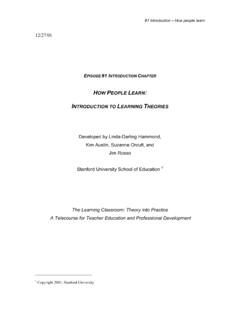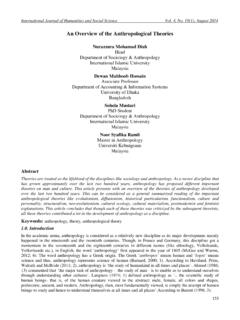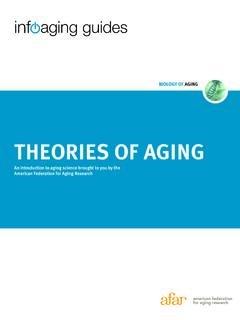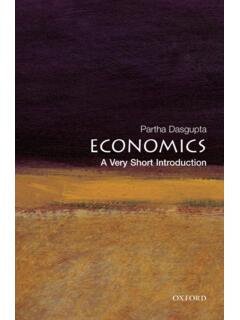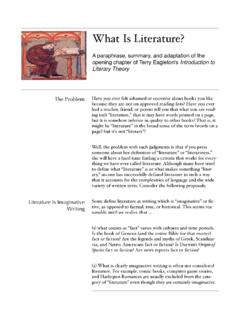Transcription of Body Language: An Effective Communication Tool
1 Body Language: An Effective Communication Tool Dipika S Patel*. Body Language is a significant aspect of modern communications and relationships. Body language describes the method of communicating using body movements or gestures instead of, or in addition to, verbal language. The interpretation of body language, such as facial expressions and gestures, is formally called kinesics. Body language includes subtle, unconscious movements, including winking and slight movements of the eyebrows and other facial expressions. Introduction Philosophers and scientists have connected human physical behavior with meaning, mood and personality for thousands of years, but only in living memory has the study of body language become as sophisticated and detailed as it is today.
2 The ancient Greeks, notably Hippocrates and Aristotle, considered the aspects of body language probably through their interest in human personality and behavior, and the Romans, notably Cicero, related gestures to feelings and communications. Francis Bacon (1605) explored gestures as reflection or extension of spoken communications. John Bulwer (1644) considered hand gestures, and Gilbert Austin's Chironomia (1806) looked at using gestures to improve speech-making. Darwin could be regarded as the earliest expert to have made serious scientific observation about body language.
3 Charles Darwin's (1800s) work pioneered much ethological thinking. Ethology began as science of animal behavior properly established during the early 1900s and increasingly extended to human behavior and social organization. Ethologists have progressively applied their findings to human behavior, including body language, reflecting the evolutionary origins of much human nonverbal Communication . Desmond Morris (1971) linked human behavior much of it concerned with communications to human animalistic' evolution. Communication Communication is conveying of ideas, thoughts, feelings, and attitude both verbally and nonverbally.
4 There are two major forms of Communication : verbal and nonverbal verbal refers to words and nonverbal refers to all Communication that occurs by means of body movements. Body language is also referred to as nonverbal Communication an important * Assistant Professor, Department of English, Naran Lala College of Professional and Applied Sciences, Navasari 396450, Gujarat, India. E-mail: 902014 IUP. All Rights Reserved. The IUP Journal of English Studies Vol. IX, No. 2, 2014. Communication tool which can constitute 50% or more of what we are communicating to other people.
5 There are two broad types of body language: open body language and closed body language. Some body language theorists say that these are very old behaviors which date back to our early ancestors. By maintaining open body language, our ancestors showed that they had no concealed weapons hidden behind their back, their armpits or in their hands. By opening our hands, unfolding our arms and bodies we still show that we mean the other person no harm. When we have closed body language, we appear to be physically showing that we are hiding something from the other person and this can be threatening to them.
6 These messages are often received subconsciously by the other person who starts to distrust our words and what we mean by them. An open manner is a good start to an open, frank conversation. Different researches were carried out on the role of body language and it has been reported that during Communication : (1) only 7% of the information human transmits to others is in the language we use; (2) 38% in how people speak quality of voice, accent, voice projection, emphasis, expression, pace, volume, pitch, etc.; and (3) 55% through body language posture, position, eye contact, facial expression, head and body movements, gestures, touch, etc.
7 Body Language Analysis Body language is instinctively interpreted by us all to a limited degree, but the subject is potentially immensely complex, and perhaps infinitely so, given that the human body is said to be capable of producing 700,000 different movements (Hartland and Tosh, 2001). As with other behavioral sciences, the study of body language benefitted from the development of brain-imaging technology in the last part of the 20th century. This dramatically accelerated the research and understanding of the connections between the brain, feelings and thoughts, and body movement.
8 We should expect to see this effort continuing and providing more solid science for body language theory, much of which remains empirical, , based on experience and observation, rather than scientific test. Given the potential for confusion, here are some considerations when analyzing body language. Figure 1 represents the important features of body language. Facial Expression Facial expressions are dynamic features which communicate the speaker's attitude, emotions, intentions and so on. The face is the primary source of emotions. During oral Communication , facial expressions change continually and are constantly monitored and interpreted by the receiver.
9 Examples are: a smile, frown, raised eyebrow, yawn or sneer. Face is the index of the mind. We say, she put on a long face to mean that she was not in the best of her moods. However much one tries, his hidden feeling of anger, fear, confusion, uncertainty, enthusiasm and joy will get revealed by the facial expression. Sometimes, the words that you utter may be contradicted by your facial expression. A. teacher might ask the student if he understood the idea, but he need not wait for an Body Language: An Effective Communication Tool 91. Figure 1: Features of Body Language Sounds Ways of Talking Posture ( , laughing) ( , pauses, stress ( , slouching).)
10 On words). Closeness ( , invading Appearance someone's space') ( , untidiness). Body Language Body Contact Head Movements ( , shaking hands) ( , nodding). Facial Expression Hand Movements ( , frown) Eye Movements ( , waving). ( , winking). answer. A lackluster bewildered facial expression would reveal that the student has not grasped anything. Eye Contact Eye movement is a key part of facial behavior because the eyes are invariably involved in facial displays. The different forms are observed to be cross-cultural. The frequency of eye contact may suggest either interest or boredom or may even betray dishonesty.
